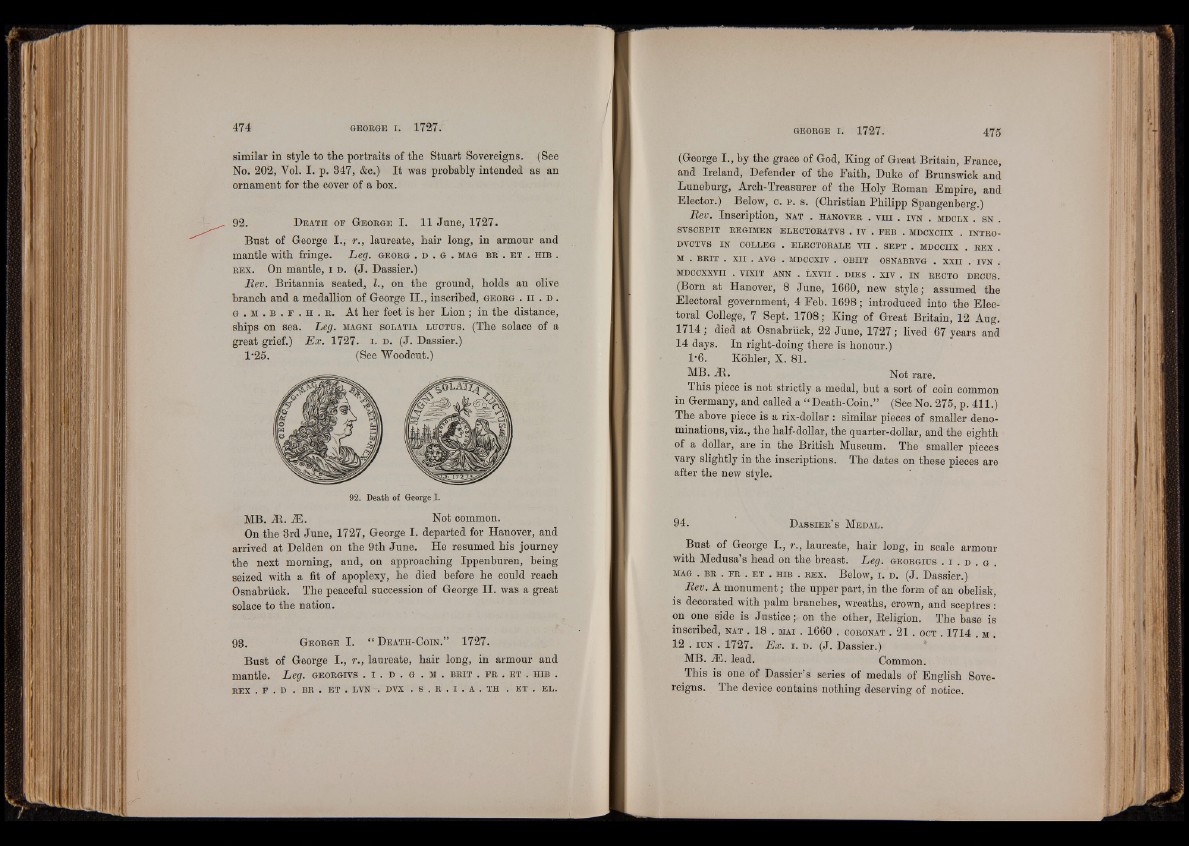
similar in style to the portraits of the Stuart Sovereigns. (See
No. 202, Yol. I. p. 347, &c.) It was probably intended as an
ornament for the cover of a box.
92. D e a t h o f G e o r g e I. 11 June, 1727.
Bust of George I., r., laureate, hair long, in armour and
mantle with fringe. Leg. g e o r g . d . g . mag b r . e t . h ib .
r e x . On mantle, i d . (J. Dassier.)
Rev. Britannia seated, I., on the ground, holds an olive
branch and a medallion of George II., inscribed, g e o r g . i i . d .
g . m . b . f . h . r . At her feet is her Lion ; in the distance,
ships on sea. Leg. m a g n i so la t ia l u c t u s . (The solace of a
great grief.) Ex. 1727. i. d . (J. Dassier.)
1*25. (See Woodcut.)
92. Death of George I.
MB. At. AC. Not common.
On the 3rd June, 1727, George I. departed for Hanover, and
arrived at Delden on the 9th June. He resumed his journey
the next morning, and, on approaching Ippenburen, being
seized with a fit of apoplexy, he died before he could reach
Osnabriick. The peaceful succession of George H. was a great
solace to the nation.
93. G e o r g e I. “ D e a t h -C o in . ” 1727.
Bust of George I., r., laureate, hair long, in armour and
mantle. Leg. g e o r g iv s . i . d . g . m . b r it . f r . e t . h ib .
REX . F . D . BR . ET . LVN . DVX . S . R . I . A . TH . ET . EL.
(George I., by the grace of God, King of Great Britain, France,
and Ireland, Defender of the Faith, Duke of Brunswick and
Luneburg, Arch-Treasurer of the Holy Roman Empire, and
Elector.) Below, o. p. s. (Christian Philipp Spangenberg.)
Rev. Inscription, n a t . h a n o v e r . vm . iv n . mdc lx . s n .
SVSOEPIT REGIMEN ELECTORATVS . IV . FEB . MDCXCIIX . INTRO -
DVCTVS IN COLLEG . ELECTORATE VII . SEPT . MDCCIIX . REX .
M . BRIT . XII . AVG . MDCCXIV . OBIIT OSNABRVG . XXII . IVN .
MDCCXXVII . VIXIT ANN . LXVII . DIES . XIV . IN RECTO DECUS.
(Born at Hanover, 8 June, 1660, new style; assumed the
Electoral government, 4 Feb. 1698; introduced into the Electoral
College, 7 Sept. 1708; King of Great Britain, 12 Aug.
1714; died at Osnabrück, 22 June, 1727; lived 67 years and
14 days. In right-doing there is honour.)
1‘6. Köhler, X. 81.
MB. At. Not rare.
This piece is not strictly a medal, but a sort of coin common
in Germany, and called a “ Death-Coin.” (SeeNo. 275, p. 411.)
The above piece is a rix-dollar : similar pieces of smaller denominations,
viz., the half-dollar, the quarter-dollar, and the eighth
of a dollar, are in the British Museum. The smaller pieces
vary slightly in the inscriptions. The dates on these pieces are
after the new style.
94. D a s s ie r ’s M e d a l .
Bust of George I., r., laureate, hair long, in scale armour
with Medusa’s head on the breast. Leg. g e o r g iu s . i . d . g .
mag . b r . f r . e t . h ib . r e x . Below, i. d . (J. Dassier.)
Rev. A monument; the upper part, in the form of an obelisk,
is decorated with palm branches, wreaths, crown, and sceptres:
on one side is Justice^on the other, Religion. The base is
inscribed, n at . 18 . m ai . 1660 . coronat . 2 1 . oct . 1714 . m .
12 . iu n . 1727. Ex. i. d . (J. Dassier.)
MB. AC. lead. Common.
This is one of Dassier’s series of medals of English Sovereigns.
The device contains nothing deserving of notice.